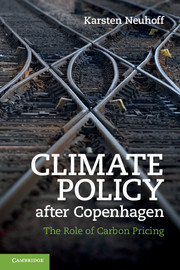Book contents
- Frontmatter
- Contents
- List of figures
- List of tables
- List of boxes
- Acknowledgements
- List of abbreviations
- 1 Introduction
- 2 The role of a climate policy mix
- 3 Implementing a carbon price: the example of cap and trade
- 4 Shifting investment to low-carbon choices
- 5 Co-operation among developed countries: a role for carbon markets?
- 6 A world of different carbon prices
- 7 International support for low-carbon growth in developing countries
- 8 Conclusion
- References
- Index
2 - The role of a climate policy mix
Published online by Cambridge University Press: 05 June 2012
- Frontmatter
- Contents
- List of figures
- List of tables
- List of boxes
- Acknowledgements
- List of abbreviations
- 1 Introduction
- 2 The role of a climate policy mix
- 3 Implementing a carbon price: the example of cap and trade
- 4 Shifting investment to low-carbon choices
- 5 Co-operation among developed countries: a role for carbon markets?
- 6 A world of different carbon prices
- 7 International support for low-carbon growth in developing countries
- 8 Conclusion
- References
- Index
Summary
Economic models have demonstrated that economic growth is possible in scenarios with both high carbon emissions and ambitious emissions reduction to limit temperature increases. Common scenarios (such as reviewed in IPCC 2007) predict that stringent climate policies will reduce GDP in 2030 by no more than 3 per cent relative to business as usual scenarios, with many models suggesting an even smaller reduction. To put this number into perspective, 3 per cent was the average of global annual GDP growth over the last thirty years. High estimates for mitigation costs therefore imply that the global GDP projected for the year 2030 is reached one year later, in 2031.
The Stern Review (2006) has identified three sets of policy interventions that are necessary to shift the economy onto a low-carbon trajectory and facilitate continued economic development:
1 Putting a price on carbon provides the economic incentive for individuals and corporations to participate in the transformation. By providing a signal to these players as to the value of various carbon-reducing options, the carbon price allows market players to make investment, production and consumption decisions in a way that minimises the impact on their economic well-being.
2 Tailored technology support encourages the development of new carbon-reducing technologies and can enhance performance and cost characteristics of existing technologies where the prospect of a carbon price alone would not be enough to motivate spending on research, development and deployment, or would not create sufficient demand for new technologies.
[…]
- Type
- Chapter
- Information
- Climate Policy after CopenhagenThe Role of Carbon Pricing, pp. 19 - 55Publisher: Cambridge University PressPrint publication year: 2011



